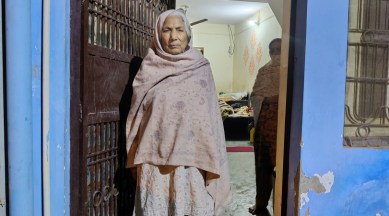Stay updated with the latest - Click here to follow us on Instagram
Delhi: First conviction in riots case, but woman whose home was burnt still lives in fear
Since February 2020, however, the structure has undergone a makeover, with the red bricks outside giving way to a coat of blue and saffron flower patterns adorning the walls. Underneath the fresh coat of paint, though, are old scars — of her home being set ablaze during the riots.

For over three decades, 67-year-old Manori called a two-storey building in Northeast Delhi’s Bhagirathi Vihar her home.
Since February 2020, however, the structure has undergone a makeover, with the red bricks outside giving way to a coat of blue and saffron flower patterns adorning the walls. Underneath the fresh coat of paint, though, are old scars — of her home being set ablaze during the riots.
monthly limit of free stories.
with an Express account.
On February 25, a mob of over 100 barged into the house and set it ablaze. Manori escaped with her daughter and two grandchildren, and spent the next month in a relative’s home.
When The Indian Express spoke to Manori on Tuesday, she was unaware of the development. “The punishment has been given but I don’t know if I should feel happy,” she said. “I don’t feel safe here. I still remember the day I ran out of my house with just one pair of clothes, clutching my daughter’s hands, running barefoot for my life. We lost everything that day. I still have nightmares of rioters outside. Pyaar mar gaya uss din, dil dukhta hai (love died that day, my heart still aches).”
As per court documents, the rioters also stole important papers such as the sale deed, gold and silver ornaments, cash, utensils, clothes and a kettle before burning the house. A buffalo and a calf also went missing in the attack. “My daughter and I don’t have jobs and my son had collected over Rs 1 lakh to buy that buffalo. We searched for it for days. Those animals were our livelihood,” she said.
They returned home a month later and began to rebuild.
Her two grandchildren, Arif and Asif, both in their 20s, work in a local steel-making unit, earning Rs 3,000 – 4,000 per month. They used the money to buy clothes and a new pair of slippers for their grandmother. Most of the renovation work was carried out with donations from local mosque committee members. The family got a compensation of Rs 50,000 from the Delhi government, which ran out during the Covid-induced lockdown.
Her daughter, Sahida Begum (50), still suffers panic attacks. “My elder son has been skipping work to stay by my side. We don’t sleep until he returns home. Sometimes I wake up at night and cry. It is tough to move on,” Begum said.
Yadav was already in judicial custody in Mandoli jail for another case when he was arrested. The prosecution had told the court his name came up in statements made by Manori and two police officers.
During the trial, Manori had deposed that she could not identify any rioters, following which the prosecution declared her a hostile witness. “I ran for my life with my family; I could not identify any rioters because they wore helmets,” she said on Tuesday.
Similarly, prosecution witnesses Arif and his brother Ashiq also deposed that they could not identify the rioters. The court said that though the three main prosecution witnesses could not identify the accused, “yet their testimonies established that their houses had been trespassed… and then set on fire by a violent mob”.
The court also noted that two police witnesses, a head constable and a constable, made depositions that “clearly established that the accused was part of the mob”.
In their deposition before the court, both officers said they did not see the accused enter the house and set it on fire, but that they had spotted the accused at the incident spot. The court said that though their testimonies reveal that the accused had not taken any active part in looting or arson, however, “it cannot be said that he was only a bystander or a passive spectator at the spot of the incident”.
The court said that the accused belongs to the Hindu community and was part of a mob which resorted to violence against Muslims, “indicating that he shared the common object of the unlawful assembly”.
“The mere fact that he was not seen entering the complainant’s house… does not mean that he was a mere bystander. There is nothing on record to show that the accused had disassociated himself from the unlawful assembly and he did not share the common object of the assembly,” the court said.